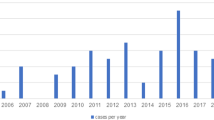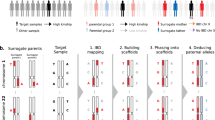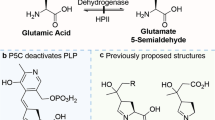Abstract
Infantile hypertrophic pyloric stenosis (IHPS) is the most common inherited form of gastrointestinal obstruction in infancy. The disease is considered a paradigm for the sex-modified model of multifactorial inheritance and affects males four times more frequently than females. However, extended pedigrees consistent with autosomal dominant inheritance have been documented. We have analysed data from an extended IHPS family including eight affected individuals (five males and three females) and mapped the disease locus to chromosome 16q24 (LOD score=3.7) through an SNP-based genome wide scan. Fourteen additional multiplex pedigrees did not show evidence of linkage to this region, indicating locus heterogeneity.
Similar content being viewed by others
Log in or create a free account to read this content
Gain free access to this article, as well as selected content from this journal and more on nature.com
or
References
MacMahon B : The continuing enigma of pyloric stenosis of infancy: a review. Epidemiology 2006; 17: 195–201.
Carter CO : The inheritance of congenital pyloric stenosis. Br Med Bull 1961; 17: 251–254.
Mitchell LE, Risch N : The genetics of infantile hypertrophic pyloric stenosis. A reanalysis. Am J Dis Child 1993; 147: 1203–1211.
Chung E, Curtis D, Chen G et al: Genetic evidence for the neuronal nitric oxide synthase gene (NOS1) as a susceptibility locus for infantile pyloric stenosis. Am J Hum Genet 1996; 58: 363–370.
Saur D, Vanderwinden JM, Seidler B, Schmid RM, De Laet MH, Allescher HD : Single-nucleotide promoter polymorphism alters transcription of neuronal nitric oxide synthase exon 1c in infantile hypertrophic pyloric stenosis. Proc Natl Acad Sci USA 2004; 101: 1662–1667.
Everett KV, Chioza BA, Georgoula C et al: Genome-wide high-density SNP-based linkage analysis of infantile hypertrophic pyloric stenosis identifies loci on chromosomes 11q14-q22 and Xq23. Am J Hum Genet 2008; 82: 756–762.
Jackson L, Kline AD, Barr MA, Koch S : de Lange syndrome: a clinical review of 310 individuals. Am J Med Genet 1993; 47: 940–946.
Smith DW, Lemli L, Opitz JM : A newly recognised syndrome of multiple congenital anomalies. J Pediatr 1964; 64: 210–217.
Heller A, Seidel J, Hubler A et al: Molecular cytogenetic characterisation of partial trisomy 9q in a case with pyloric stenosis and a review. J Med Genet 2000; 37: 529–532.
Hodgson SV, Berry AC, Dunbar HM : Two brothers with an unbalanced 8;17 translocation and infantile pyloric stenosis. Clin Genet 1995; 48: 328–330.
Finsen VR : Infantile hypertrophic pyloric stenosis – unusual familial incidence. Arch Dis Child 1979; 54: 720–721.
Fried K, Aviv S, Nisenbaum C : Probable autosomal dominant infantile pyloric stenosis in a large kindred. Clin Genet 1981; 20: 328–330.
Capon F, Reece A, Ravindrarajah R, Chung E : Linkage of monogenic infantile hypertrophic pyloric stenosis to chromosome 16p12-p13 and evidence for genetic heterogeneity. Am J Hum Genet 2006; 79: 378–382.
Ott J : Computer-simulation methods in human linkage analysis. Proc Natl Acad Sci USA 1989; 86: 4175–4178.
Weeks DE, Ott J, Lathrop GM : SLINK: a general simulation program for linkage analysis. Am J Hum Genet 1990; 47: A204 (abstr).
Abecasis GR, Cherny SS, Cookson WO, Cardon LR : Merlin – rapid analysis of dense genetic maps using sparse gene flow trees. Nat Genet 2002; 30: 97–101.
Barrett JC, Fry B, Maller J, Daly MJ : Haploview: analysis and visualization of LD and haplotype maps. Bioinformatics 2005; 21: 263–265.
Li S, Whorton AR : Identification of stereoselective transporters for S-nitroso-L-cysteine: role of LAT1 and LAT2 in biological activity of S-nitrosothiols. J Biol Chem 2005; 280: 20102–20110.
Gudbjartsson DF, Jonasson K, Frigge ML, Kong A : Allegro a new computer program for multipoint linkage analysis. Nat Genet 2000; 25: 12–13.
Schlossmann J, Feil R, Hofmann F : Signaling through NO and cGMP-dependent protein kinases. Ann Med 2003; 35: 21–27.
Foster MW, McMahon TJ, Stamler JS : S-nitrosylation in health and disease. Trends Mol Med 2003; 9: 160–168.
Li S, Whorton AR : Functional characterization of two S-nitroso-L-cysteine transporters, which mediate movement of NO equivalents into vascular cells. Am J Physiol Cell Physiol 2007; 292: C1263–C1271.
Acknowledgements
We thank all the families who participated in this study. We are grateful to K Parker for technical assistance and to K Rogers and J Mulligan for their contribution to ascertainment work. This work was funded by Birth Defects Foundation Newlife and Action Medical Research.
Author information
Authors and Affiliations
Corresponding author
Additional information
Web Resources
The URLs for data presented herein are as follows:
Ensembl, http://www.ensembl.org/Homo_sapiens/index.html
GeneCards, http://www.genecards.org/index.shtml
Online Mendelian Inheritance in Man (OMIM), http://www.ncbi.nlm.nih.gov/omim/
UniGene, http://www.ncbi.nlm.nih.gov/sites/entrez?db=uniGene
Supplementary Information accompanies the paper on European Journal of Human Genetics website (http://www.nature.com/ejhg)
Rights and permissions
About this article
Cite this article
Everett, K., Capon, F., Georgoula, C. et al. Linkage of monogenic infantile hypertrophic pyloric stenosis to chromosome 16q24. Eur J Hum Genet 16, 1151–1154 (2008). https://doi.org/10.1038/ejhg.2008.86
Received:
Revised:
Accepted:
Published:
Issue date:
DOI: https://doi.org/10.1038/ejhg.2008.86
Keywords
This article is cited by
-
A novel missense mutation in the transcription factor FOXF1 cosegregating with infantile hypertrophic pyloric stenosis in the extended pedigree linked to IHPS5 on chromosome 16q24
Pediatric Research (2017)
-
Genome-wide linkage analysis in families with infantile hypertrophic pyloric stenosis indicates novel susceptibility loci
Journal of Human Genetics (2012)
-
Open Versus Laparoscopic Pyloromyotomy for Hypertrophic Pyloric Stenosis: A Systematic Review and Meta-Analysis Focusing on Major Complications
Surgical Endoscopy (2012)
-
No association between the SNPs (rs56134796; rs3824934; rs41302375) in the TRPC6 gene promoter and infantile hypertrophic pyloric stenosis in Chinese people
Pediatric Surgery International (2011)



